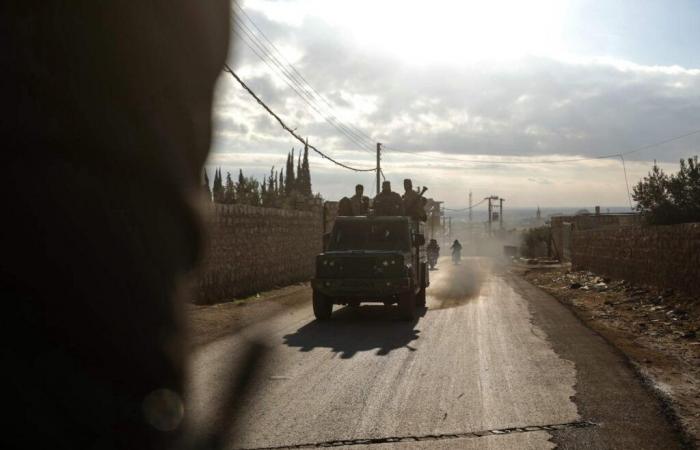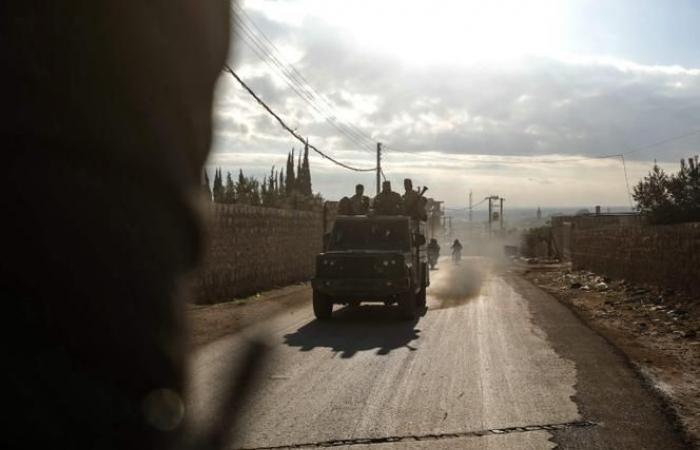Fighting in northern Syria between regime forces and jihadists, who launched an offensive against government-controlled territories on Wednesday, left more than 200 dead, according to a new report provided Thursday, November 28 by the Observatory Syrian Human Rights Organization (OSDH).
These are 102 jihadist fighters from Hayat Tahrir Al-Cham (or HTC, “Levant Liberation Organization”), 19 members of allied groups, and “61 members of the regime forces”according to the non-governmental organization (NGO) based in London and which has a vast network of sources in Syria. Civilians are among the dead: 19 were killed Thursday in strikes by the Russian air force, an ally of the Syrian regime, adds the Observatory, specifying that a civilian had been killed by bombings by the Syrian army the day before.
These are the most violent clashes since 2020 in northwest Syria, where the province of Aleppo, largely in the hands of Bashar Al-Assad's regime, borders the last major rebel and jihadist stronghold of Idlib. .
The United Nations Office for the Coordination of Humanitarian Affairs (OCHA) reported that “more than 14,000 people – almost half of whom are children – have been displaced” due to the violence. The Syrian defense ministry said it faces a “vast attack” of the “terrorist organizations” in the Aleppo region.
Road linking Damascus to Aleppo cut
Kioumars Pourhashemi, a general in Iran's Revolutionary Guards, was also killed, according to an Iranian news agency. Iran is an unwavering ally of Syria, a country in which Tehran is involved militarily, sending advisors, at the request of local authorities, to support President Bashar Al-Assad during the Syrian civil war.
The spokesperson for Iranian diplomacy, Esmaeil Baghaei, estimated Thursday that the current offensive was “part of a diabolical plan of the terrorist regime [Israël] and the United States »and called for “firm and coordinated action to prevent the spread of terrorism in the region”.
Read also | Article reserved for our subscribers In cards: the game of foreign influences in Syria
Read later
Jihadists and their allies cut the vital road linking the capital Damascus to Aleppo, the country's second city, on Thursday, according to the OSDH. They also took control of the road intersection between Aleppo and the coastal city of Latakia, according to the same source. The NGO reported villages conquered by jihadists in western Aleppo province and in a government-held sector of Idlib province.
In addition to rocket fire and “intense artillery fire”, “Russian aviation”acting in support of the regime, “intensified its airstrikes”targeting in particular the surroundings of Sarmine, in the Idlib region, according to the OSDH.
The most violent clashes since 2020
HTS, dominated by the former Syrian branch of Al-Qaeda, controls parts of the province of Idlib, but also neighboring territories in the regions of Aleppo, Hama and Latakia. In a press conference, the head of the self-proclaimed “government” in Idlib, Mohammad Al-Bashir, claimed that the offensive had been launched “because the criminal regime had massed forces on the front lines and started bombing civilian areas, which caused the exodus of tens of thousands of civilians”.
The Memorable World
Test your general knowledge with the editorial staff of “Le Monde”
Test your general knowledge with the editorial staff of “Le Monde”
Discover
Analyst Nick Heras of the New Lines Institute for Strategy and Policy believes the rebels “tried to anticipate the possibility of a Syrian military campaign in the Aleppo region, which was being prepared by airstrikes by the Russian and Syrian governments”.
Northern Syria has benefited from a precarious calm in recent years, made possible by a ceasefire established after a regime offensive in March 2020. The truce was sponsored by Moscow and Ankara, with the Turkish government supporting certain groups. Syrian rebels on its border. At the same time, Turkey “sends a message to Damascus and Moscow to renounce their military efforts in northwest Syria”added the analyst.
The Syrian regime has regained control of a large part of the country with the support of its Russian and Iranian allies since the outbreak in 2011 of the conflict which left more than half a million dead and displaced millions of people. .
Where is the war in Syria today? Understand in three minutes
Like Tunisia, Libya or Egypt, in 2011, Syria was one of the countries whose authoritarian power was destabilized by the “Arab Spring”. The dictatorship of the Bashar Al-Assad clan, in power since the 1970s, bloodily represses the peaceful demonstrations led by part of the Syrian population to demand more freedom.
See also | Eight years ago, Syria rose up… How the country descended into war and terrorism
Read later
In the process, many soldiers defected and created the Free Syrian Army (FSA), which became the main component of the rebels determined to take up arms to overthrow the regime.
In the years that followed, the opposition to Bashar Al-Assad gained ground, conquering important cities in the territory. To the political conflict is added the religious and ethnic conflict, because the rebels are a heterogeneous group, made up of militias of opponents of the regime, religious and ethnic minorities like the Kurds, as well as radical Islamist groups, like the organization Islamic State (IS). This will take advantage of the instability to conquer an important territory. The rise of the Islamist group will eventually convince foreign powers to intervene in the conflict.
In 2019, ISIS was defeated in Syria, and the regime of Bashar Al-Assad recaptured two-thirds of the territory. The opposition is gathered in the north-western province of the country. The front lines have been frozen ever since.
In this video, we look back at the major moments of the Syrian conflict up to the current situation. To date, it is estimated that the war has left more than 500,000 dead. To better understand what life is like in Syria today, we invite you to read the report below.
Read also | Article reserved for our subscribers Syria: trip to a bloodless country
Read later
“Understand in three minutes”
The explanatory videos that make up the “Understand in three minutes” series are produced by the Vertical Videos department of the Monde. Broadcast primarily on platforms such as TikTok, Snapchat, Instagram and Facebook, they aim to put major events into context in a short format and make the news accessible to everyone.







